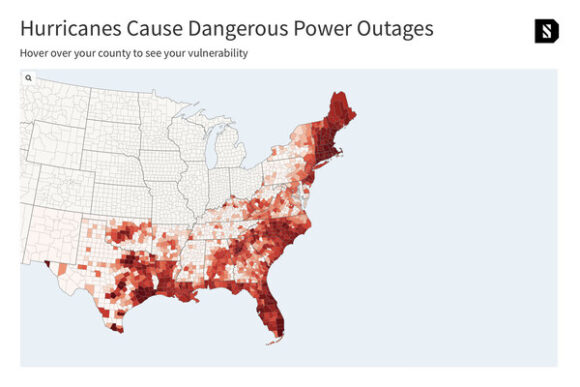New research indicates that what used to be the 100-year hurricane will now happen every 25 years, according to Deep Sky Research, a Montreal-based carbon removal project developer.
The new report analyzes data within the U.S. via its Hurricane Rainfall Model to examine how hurricane risk is changing due to climate change.
The analysis resulted in six key findings:
1. Frequency of deadly hurricane weather has jumped 300 percent.
Deep Sky Research’s model finds that severe hurricane rainfall (which causes damages and deaths) that used to occur only once every 100 years will now happen every 25. In addition, the probability of smaller storms has doubled.
2. Severity of extreme hurricane rainfall has grown 33 percent.
Not only has the frequency of extreme hurricane rainfall increased, but the maximum severity is growing as well, the report found.
3. Hurricanes could cost more than $450B in the next 5 years (a 50 percent increase).
Deep Sky Research built a proprietary machine learning model that projects losses of more than $450B USD in the next 5 years across Gulf and South Atlantic coast states due to hurricanes. Florida is expected to have the greatest losses, with Texas a close second.
4. Gulf Coast states face greatest rainfall increases.
States along the Gulf Coast including Texas, Louisiana and Mississippi should expect the greatest increases while those on the Atlantic coast such as North Carolina and South Carolina will see smaller increases, the analysis found.
5. Flash flooding will now hit South Atlantic counties every year.
Storm surge is worsening because hurricanes are getting stronger but also because sea levels are rising. This means that when a storm surge occurs, flooding is more severe. Miami is extremely vulnerable to flash flooding caused by hurricanes, for example.
6. Houston is most vulnerable to hurricane-caused power outages.
Houston is particularly vulnerable due to its likelihood of being in the path of severe storms and its well-documented power grid issues, the report added.
Most deaths caused by hurricanes are a result of the massive volumes of water they drop on coastal areas.
Deep Sky Research analyzed millions of public data points to build a Hurricane Rainfall Model based on the past four decades of climate data to examine these trends, which found that the frequency and severity of extreme hurricane rainfall is climbing.
“Deep Sky Research uses a risk assessment approach for predicting the impact of climate change,” said Max Dugan-Knight, Deep Sky climate data scientist. “Just like those used by the insurance industry, a risk-first approach helps us quantify disasters before they happen. In the case of hurricanes, an increase in frequency and severity is being driven by record-breaking sea surface temperatures.”
Deep Sky Research developed an interactive map to show flood hazard predictions in each Atlantic coast county of the continental US. By hovering over each county, it shows how deadly hurricane weather is becoming more frequent and more severe. The darker purple the county, the greater the flood risk.
Flooding is most destructive in densely populated areas. Miami’s three counties are extremely vulnerable to flash flooding caused by hurricanes, for example. One storm per year is now expected, on average, to reach 2.5 feet of flooding in Miami Beach, for example.
The damage and loss of life from hurricanes are aggravated by the power outages they cause. Data from the past decade shows where the grid is most vulnerable to hurricane-caused power outages.
Many of the impacts of climate change are slow-moving, but some will be devastating in their rapid escalation. Deep Sky said the U.S. will see worsening hurricanes not in the next 50 years, but in the next five.
To read the full report, visit deepskyclimate.com/research.
Was this article valuable?
Here are more articles you may enjoy.



 Markets/Coverages: Baltimore Bridge Collapse Sparks Port Blockage Cover From Marsh
Markets/Coverages: Baltimore Bridge Collapse Sparks Port Blockage Cover From Marsh  Morgan Stanley’s and Hiscox’s Bloomer Among Those Missing After Yacht Sinks
Morgan Stanley’s and Hiscox’s Bloomer Among Those Missing After Yacht Sinks  Harvard Contract Breach Claims Blaming Marsh for Its $15M Insurance Denial Filed Too Late, Judge Rules
Harvard Contract Breach Claims Blaming Marsh for Its $15M Insurance Denial Filed Too Late, Judge Rules  The Huge Profits Investors Have Made on Catastrophe Bonds Are Raising Eyebrows
The Huge Profits Investors Have Made on Catastrophe Bonds Are Raising Eyebrows 

